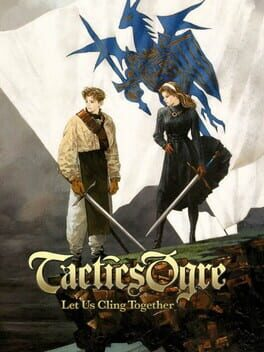subdirectory_arrow_right Ogre Battle: The March of the Black Queen (Game), Tactics Ogre: Let Us Cling Together (Game), Ogre Battle (Collection)
▲
2
▼
The series takes several naming cues from the English glam rock band Queen, who are highly popular in Japan. The name of the series itself, Ogre Battle, comes from a song off of Queen's 1974 sophomore album Queen II; another song on the album, "The March of the Black Queen", is the namesake for the series' first installment. The second game, Tactics Ogre: Let Us Cling Together, takes its name from Queen's 1976 song "Teo Torriatte (Let Us Cling Together)", an homage to their Japanese fanbase.
Another Queen reference in The March of the Black Queen can be found with one of its regions, the Rhyan Sea. The area's name comes from "Seven Seas of Rhye", a song which appears in an unfinished instrumental form on Queen's 1973 self-titled debut and was later completed with vocals on Queen II.
Another Queen reference in The March of the Black Queen can be found with one of its regions, the Rhyan Sea. The area's name comes from "Seven Seas of Rhye", a song which appears in an unfinished instrumental form on Queen's 1973 self-titled debut and was later completed with vocals on Queen II.
▲
1
▼
In a 1995 interview with the game's director Yasumi Matsuno, found within the Dengeki SFC magazine, he clarified that the game was a part of the Ogre Battle series, but it was not a direct sequel to Ogre Battle: The March of the Black Queen. The games' world and environments are shared, but the gameplay systems are completely dissimilar. When asked why the gameplay system was changed, he responded:
"First off, after we finished the Ogre Battle development, we determined that doing another 3D real-time simulation game for the Super Famicom was going to be difficult. There is a special chip now for the SFC that offers more possibilities, but it’s also very expensive to use [this could be referring to the Super FX chip]. Therefore, we abandoned the idea of doing another, powered-up version of Ogre Battle, and instead decided to develop a brand new system."
"Another reason was that we actually started the planning for Tactics Ogre three months before the release of Ogre Battle. To decide on a direct sequel then would have been pointless if Ogre Battle didn’t sell well, and we didn’t have any confidence that it would. Ultimately it was very popular, so we carried over just the world and setting."
"Also, in Ogre Battle the units moved in real-time, which meant you couldn’t take your time and plan out a strategy. For us, this was a big point we wanted to improve on. From the beginning of the Tactics Ogre development, therefore, we never saw real-time as an option."
"First off, after we finished the Ogre Battle development, we determined that doing another 3D real-time simulation game for the Super Famicom was going to be difficult. There is a special chip now for the SFC that offers more possibilities, but it’s also very expensive to use [this could be referring to the Super FX chip]. Therefore, we abandoned the idea of doing another, powered-up version of Ogre Battle, and instead decided to develop a brand new system."
"Another reason was that we actually started the planning for Tactics Ogre three months before the release of Ogre Battle. To decide on a direct sequel then would have been pointless if Ogre Battle didn’t sell well, and we didn’t have any confidence that it would. Ultimately it was very popular, so we carried over just the world and setting."
"Also, in Ogre Battle the units moved in real-time, which meant you couldn’t take your time and plan out a strategy. For us, this was a big point we wanted to improve on. From the beginning of the Tactics Ogre development, therefore, we never saw real-time as an option."
▲
1
▼
According to game's director Yasumi Matsuno in a 1995 Dengeki SFC magazine interview, it took the developers two and a half years (including several delays) to make the game, and by the end expressed that he was extremely tired from its development.
Related Games
Tactics Ogre: Let Us Cling Together
Ogre Battle: The March of the Black Queen
Ogre Battle 64: Person of Lordly Caliber
Final Fantasy IV: The Complete Collection
Drakengard 2
Overwatch
SaGa: Scarlet Grace - Ambitions
Etrian Odyssey Untold: The Millennium Girl
Final Fantasy X-2
Trauma Center: Under the Knife 2
Shin Megami Tensei Devil Summoner: Raidou Kuzunoha vs. The Soulless Army
Final Fantasy Tactics Advance
Persona 4 Golden
Shin Megami Tensei: Nine
Skylanders: Giants
Mario Hoops 3-on-3
Persona 3 Reload
Persona 5 Royal
Deus Ex: Human Revolution
SinoAlice
Bravely Default II
Final Fantasy V
Major Minor's Majestic March
Musashi: Samurai Legend
Kingdom Hearts
Bahamut Lagoon
Drakengard 3
Final Fantasy IX
Shin Megami Tensei: Devil Summoner - Soul Hackers
Chrono Trigger
Final Fantasy IV: The After Years
Kingdom Hearts Union χ[Cross]
Fortune Street
Gex Trilogy
ActRaiser
Kwirk
Shining Force: Resurrection of the Dark Dragon
Persona 2: Innocent Sin
Fossil Fighters
The Neverhood
Kingdom Hearts HD 2.5 Remix
Demon's Souls
Stranger of Paradise: Final Fantasy Origin
Steambot Chronicles
Shin Megami Tensei: Devil Survivor
The 3rd Birthday
Final Fantasy XV
3D Dot Game Heroes
Final Fantasy VI
Lightning Returns: Final Fantasy XIII
